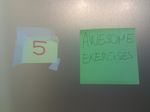I recently had a group of employees from one company who said their management was…
The Happiness Door, Another Great Feedback Method
Do you want to collect feedback during your course or conference? Try the happiness door! It works well for me.
Sometimes people just write “awesome game!” or “I love the discussions”. Sometimes they just leave a smiley, or a blank note. But other participants have more specific feedback to share, such as “The slides contained too many quotes. Please use pictures!” or “Too much theory” or “More room for theory!” (Yes, I once received the last two at the same time.)
It appears the happiness door works well for me.
Feedback Door + Happiness Index
 The method is very simple. You ask people to give you immediate feedback after a presentation, a training session, a workshop, a business meeting, a lap dance, or any other intellectual performance. You want that feedback quickly because in most people’s brains impressions dissolve faster than European credit ratings. You also want it soon so that you can act on the feedback and minimize the suffering caused by your embarrassing mistakes.
The method is very simple. You ask people to give you immediate feedback after a presentation, a training session, a workshop, a business meeting, a lap dance, or any other intellectual performance. You want that feedback quickly because in most people’s brains impressions dissolve faster than European credit ratings. You also want it soon so that you can act on the feedback and minimize the suffering caused by your embarrassing mistakes.
I take credit for inventing the happiness door earlier this year, and I have been calling it a feedback door for a while, which led to some confusion. Several trainers told me they had invented the “feedback door” years before me, but it turns out they didn’t do what I describe here. Usually people just collect optional feedback on a wall, a window, or a coffee machine. The crucial part of the happiness door is that it is a happiness index and a feedback door. Its purpose is to generate qualitative feedback (comments) and numerical feedback (ratings).
Happiness doors were successfully used at the ALE2011 and LESS2011 conferences. (In both cases I was unaware of the organizers’ brilliant strokes of thievery, until I saw the doors in action.) I noticed plenty of tweets and comments of people appreciating this way of collecting feedback by conference organizers, which is similar to the comments I receive from attendees of my courses.
Tips for Your Happiness Door
Several things are important to consider for successful implementations of the happiness door:
- The happiness door should be strategically placed, for example, next to the exit of the room. Preferably it should be a place where everyone walks past when a conference talk or training session has ended.
- All participants must understand the scale of the happiness index (5 = excellent … 1 = bad). If you don’t explain this at the end of the session then consider highlighting it on the door itself.
- Attendees should be told that empty notes are OK. A rating without a comment is still better than not getting feedback at all. (And some people figure out how to write comments without giving a rating.)
- Organizers may want to consider distributing sticky notes in a not-very-subtle way. (At the LESS2011 conference there were sticky notes attached to the backs of all chairs.)
- In my courses I explicitly ask for feedback twice per day, before lunch and at the end of the day. More often is overdoing it. Though some people use the door any time they want, which is great.
- I make it clear to everyone that I actually read the notes. I read some of them out loud, and then I explain why some of my work sucks, and what I will do about it. Some people appreciate that.
- It is easy to collect the results. I always take a picture of the door first, and I save the notes in an envelope. (If you want to keep the scores just write them on the notes, or use five different envelopes.)
Other Feedback Methods
Of course, there are different ways of collecting feedback. The happiness door is just the method that I prefer. Other options I’ve seen:
- Some organizers collect feedback in hallways, but I like it to be more “in-your-face” near the exit of the room.
- Some organizers use paper forms and closed boxes, but I like the feedback to work as an information radiator.
- Some organizers collect feedback in three colors (red, yellow, green) but I think the happiness index (1 to 5) is a more useful scale.
- And some trainers collect only comments as qualitative feedback, but I’ve noticed some attendees are more comfortable with ratings.
The happiness door combines the best of all feedback mechanisms I have seen being used. But you may put a note on my door saying "You're biased".
Reflexive Feedback
 One interesting side-effect of this method is that it is reflexive. I am quite sure that the information radiator not only collects but also influences the feedback of participants. When people give negative feedback, it is likely that more people will do the same. And if the door only shows high ratings, it might make other people feel better.
One interesting side-effect of this method is that it is reflexive. I am quite sure that the information radiator not only collects but also influences the feedback of participants. When people give negative feedback, it is likely that more people will do the same. And if the door only shows high ratings, it might make other people feel better.
And besides, many people appreciate an event even more when the approach to feedback is open and transparent. Just the fact that there is a happiness door means people are unlikely to put anything at the bottom of the door! This also saves them some strain in their backsides because nobody needs to bend over. And thus everyone is even happier.
Did you try the happiness/feedback door? Have you tried it in your organization, after a meeting or a presentation? Add your experiences and suggestions to this blog post. I might use it in upcoming books or articles.




